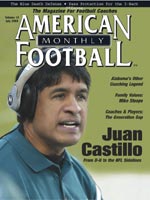Article CategoriesAFM Magazine
|
The Ravens\' NestAnderson University\'s I-Back pass protection© More from this issue At Anderson University, we are committed to throwing the football
on any down and distance anywhere on the field. We led NCAA Division
III in passing offense at 383 yards per game last fall while finishing
7th in total offense at 470 yards per game. Throwing the ball 505
times last season, we gave up 19 sacks in which only 12 were due
to protection breakdowns not on the quarterback. That comes out
to 1 sack every 26.5 attempts or less than two a game. Itís
a true testament to our players believing in our system and their
willingness to learn. Our offensive line is the absolute key to
our success.
|
|
|||||||
| HOME |
MAGAZINE |
SUBSCRIBE | ONLINE COLUMNISTS | COACHING VIDEOS |
Copyright 2025, AmericanFootballMonthly.com
All Rights Reserved





